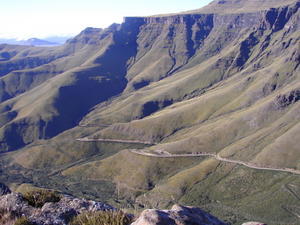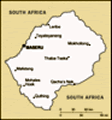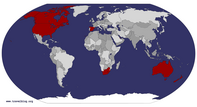Advertisement
Published: March 29th 2007

 The Sani Pass Road
The Sani Pass Road
it seems to be taking us to the Roof of Africa! Lesotho: The Roof of Africa (March 25-29, 2007)
The gravel road snaked its way up, through, around and up again over the seemingly never-ending range of mountains. The four-wheel drive whined as it carefully edged its way over cavernous holes and ruts, the loose rocks churning under the wheels, getting ever closer to the plateau of cliff known as the Drakensberg Range. I peered over the very close edge and looked down into the bottomless canyon. “What’s that?”, I asked our guide, Steven, as he carefully maneuvered the route.
“It’s a Mercedes truck that didn’t make the turn,” he said. “And quick, look at that…it’s the Drakensberg siskin… a bird found no where else in the world!”
There have been few destinations in our travels that have caused me to be at a loss for words, but the trip into Lesotho (pronounced Le-soo-too) via the Sani Pass is such an experience. It is the only leg of our trip for which we had pre-hired a guide, and we were delighted to have made this choice. Steven Piper, owner with his charming wife, Andi, of Pied Piper Expeditions, is a retired professor. His new career combines his previous

 Still going up!
Still going up!
The views were beyond description!research specialty (he is a world renowned expert in vultures) with a new found love of birds in general and the small country of Lesotho. After a night in the Piper’s spacious bed and breakfast accommodation, Craignish Cottage, we had made the early morning start up the famous Sani Pass in Steven’s Toyota Land Cruiser.
The small independent country of Lesotho (which is about the size of Belgium) is completely surrounded by South Africa. The Sani Pass is the access route through the magnificent Drakensberg Mountain Range, and is only accessible by 4-wheel drive. What a road it is! As the vehicle continues to climb, it is hard to know where to look. The mountains literally surround the narrow pass, rising in shades of green to peaks and plateaus that elicit wows at ever hairpin turn. They seem endless, and while you know that you will eventually drive up and over the cliff face in the horizon, it really doesn’t seem possible that you can do it.
Our drive is punctuated by stops for looks at many birds. Having an expert guide is a rare experience for us, and we are both caught up in the excitement of

 On the top of the Sani Pass
On the top of the Sani Pass
We are standing on the top of the mountain pass, with the Sani Pass Road snaking its way below us!!seeing such beautiful feathered creatures…a white stork poses for us, jackal buzzards soar and land, brilliant yellow and cape canaries flutter, orange breasted rock jumpers flit and sickle winged chats land beside the road. The first morning, Hector has marked 37 new birds on his list, and that list actually grew to a stunning total of 85. The birds were, even for a neophyte like myself, remarkable!
We had to have our passports checked at both the South African Border Crossing and again at the entrance to Lesotho. The latter was literally at the top of the mountain range, and by that time, we were so awed by the views we didn’t think that we could get more impressed. We were wrong.
Our ‘home’ for the next two nights was the Sani Top Chalet, billed as the highest pub in the world. At 2874 meters, the thinness of the air is apparent, and the almost gale force winds make us both glad we have on that outer windproof layer we have been carrying since January! Our small stone rondavel (the name for this type of round structure) is amazingly comfortable, with a great bed and ensuite bath. We

 Lesotho Immigration Office
Lesotho Immigration Office
Pass port check to get out of Africa )isn't that a movie?) , and another to get into Lesotho!will be grateful to climb under the duvet, though, as the merciless wind seeps through the cracks in the windows and under the door.
We spend the afternoon doing one of the spectacular hikes of our trip. Steven, who has tailored our trip to our interests, has hired a local Lesotho guide named Adolph to accompany us on the trek up Hodgesons Peak, a stunning mountain whose peak we can just see from the chalet. Standing at 3257m, we knew it would be a taxing walk for us, but I admit to being surprised (and dismayed) at how difficult it was to breathe at this altitude. Even as we began the walk over the stubble of the harsh Lesotho turf, I wondered what that unusual noise was in my ears. Then I realized it was my own raspy shallow breathing! Without even exerting myself, it presented a problem, and I was dismayed at how it persisted throughout the climb.
The hike was incredible, both for the long-range views of endless miles of mountains and canyons, and the interesting landscape close at hand. We were greeted by passing shepherds, dressed in the traditional wool blankets and gum rubber boots that

 Our 'rondavel'
Our 'rondavel'
It was really comfy inside. A generator gave us power for a few hours each evening...and the bedding was warm (thank goodness!!)are the custom for Lesotho. They whistled to their sheep and called loudly to Adolph, who answered back in the loud and rapid Sesotho language. Hundreds of sheep dotted the landscape as well as some cattle and a few smile -producing burros, the common beast of burden. With numerous stops for me to ‘catch my breath’, we continued to ascend, the last part of the climb requiring considerably more effort as we reached the boulders of the upper levels. As much as I hate to admit defeat, I decided (at what I learned later was not more than 10 minutes from the top), that I wasn’t going to push myself any further, and Hector and Adolph made the final ascent without me. I regret the decision, but the whole shallow breathing thing, a combination (we think) of the altitude, the wind and the malaria medication we were on, made it seem more prudent to stay behind! Hector declared the views from the summit were breathtaking!
Four and a half hours after our walk began, we were back at the Sani Top Chalet, glad to get a reprieve form the wind. Meals at the Pub were terrific, served by the

 Hodgesons peak
Hodgesons peak
This peak was up over the 10 000 ft mark...and the air was thin !local staff buffet style! It was great to be sitting at the top of the Drakensberg Range, safe from the elements and enjoying a meal with people from New Zealand, London, South Africa and other corners of the world. Very special. It was also somewhat disconcerting to know that mere meters from our rondavel, were the homes of a small village at the top of the pass, where the stone houses were open to the elements, the meals cooked over an open fire in the center of the stone hut and the rough wool blankets providing insufficient protection against the cold. Traveling reminds us how fortunate we are and how much help people of the world require.
The next day we ventured further inland and got a better sense of life in Lesotho. Again, Steven had hired a local woman, a young mother who had been provided a training program in bird identification by one of the local projects. It is her hope to get work as a guide. Tourism has the promise of providing meaningful work where it is needed, but the careful management of this new industry is critical. “Cecilia” as she wants to be called (her

 The hike
The hike
Hec following our guide, Adolph! Taking the photo gave me a good excuse to catch my breath (or try to!).Lesotho name was difficult) gave us insight into her life and the culture of the country. She also interpreted as we met people on the trail. We saw more shepherds, riding on tall horses, their balaclavas pulled over their faces to protect from the wind (both the cold and the sand are menaces). We delighted in a conversation with two young boys, age 10 and 15, who were taking a sack of millet to a shepherd miles and miles from where we met them. They do attend school (this was a Sunday) and one of the boys told me he liked mathematics the best. They were fascinated with Cecelia’s bird book and the binoculars, wanting to know if you could see into the earth with them! We first saw them around 10 a.m. and we saw them walking their return route more than 7 hours later! We saw other young men who were not students; being a shepherd and living in the hills with the animals is the choice for many.
As we traveled and bird watched, we caught glimpses of life into the small rural villages in the mountains. If a white flag is flying outside one of

 Lunch break
Lunch break
A great place to stop with stunning views in all directions (see next pics)the stone huts the woman there is selling bread. A yellow flag means beer is for sale; a red flag, meat. We saw groups of women doing laundry in the rivers and men using cattle to haul firewood. Sanitation is a real problem for the small villages and only recently has the outdoor toilet become part of these communities, a result of aid projects. Despite the hardships, the people are generally a friendly lot and many seem to value education. Adolph told us proudly of his ‘first born’ (a son) attending high school in Durban, a city on South Africa. His other 2 children will not attend, partially because of the huge costs, and partially because one is a girl! Cecelia told us, upon query, that educated men treat women quite well, but uneducated men do not-they think they are the boss, she said, and will push their women around to make their point. Interesting. Some problems are universal.
We visited the small town of Mehotlong, where there were more services, shops and schools, as well as several churches. Throngs of villagers were returning from church as we drove through, many dressed in their Sunday best and carrying Bibles.

 Looking down on the clouds
Looking down on the clouds
For much of the walk, we were looking down on clouds...and outward at miles of untouched mountains.As we continued our drive, many young children would run toward the car, hands outstretched, asking for sweets (or ‘bonbons’…influence of French missionaries) or money.
Steven talked a lot about working with the local communities, especially those close to the Sani Top area, to make tourism a positive influence. He is part of a group which has formed to develop a cooperative approach to the task.
Our time in Lesotho passed all too quickly. One more evening meal, another night snuggled to stay warm in the rondavel and we said good-bye to this fascinating part of the world. It left an indelible mark on us both, and we will seek to find ways to contribute in a positive manner to its future.
Our final half-day back in South Africa with Steven Piper allowed us to meet two more wonderful people. Philip is a hiking guide and Christeen is a naturalist specializing in San Rock Art. Steven had arranged for them to accompany us on another stunning walk (much shorter than in Lesotho!) where we could view San Rock art, incredible rock paintings done by the San people who had inhabited this part of the world as long

 Back at the chalet
Back at the chalet
We said goodbye to Adolph back at The Sani Top Pub and Chalet.as 25000 years ago. The San are a lost culture, having been driven out by white settlers and assimilated over the years. Their art is a reminder of an ancient nomadic way of life, and it was a real treat to be able to view it in such a beautiful and untouched atmosphere.
We must give accolades to Pied Piper Expeditions and Steven and Andi Piper. Their attention to our interests, their warm hospitality and their professional guiding made our visit to Lesotho and the Drakensberg Mountain region one of the highlights of our time away. Independent traveling is wonderful, but there are times when a professional can add so much more to the experience. This was truly one of those times.
Advertisement
Tot: 0.104s; Tpl: 0.014s; cc: 10; qc: 56; dbt: 0.0584s; 1; m:domysql w:travelblog (10.17.0.13); sld: 1;
; mem: 1.2mb
























Brenda
non-member comment
waiting for Lesotho
Oh Nancy! I've been waiting for the photos and commentary on Lesotho and it is not what I expected. Your entry reminded me so much of our experience in Nepal and I can see the commonalities in terms of mountain life. We, too, found the experience most humbling. As our memories are locked in our minds, so too will yours. Can hardly wait to have you home to see and hear more. B